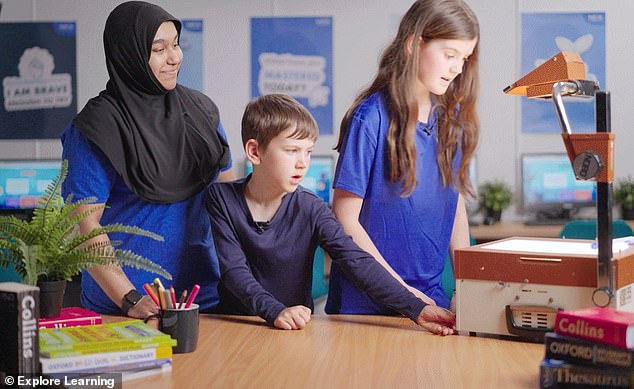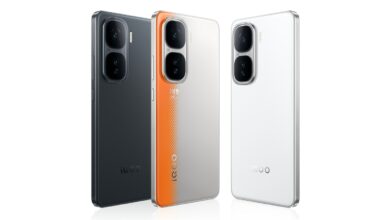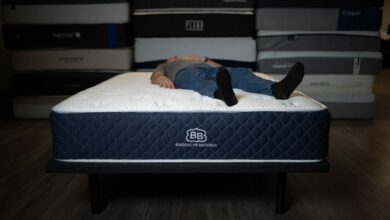The everyday 1990s objects children have never heard of: New poll reveals 61% of 10-year-olds don’t know what a floppy disk is – so, how many items do YOU remember?

It was only a couple of decades ago that schools were filled with floppy disks, overhead projectors and cassette players.
So it’s testament to how quickly technology has changed that today’s young students don’t even recognise these beloved machines.
A hilarious new video shows a class of 10-year-olds trying to identify everyday 1990s objects – without much success.
One child thinks a cassette is a battery, while another mistakes a floppy disk for a calculator and someone else tries to activate a boombox by saying ‘Hey Google’.
So, which of these retro gadgets do you remember?

Hilarious new video shows a class of 10-year-olds trying to identify floppy discs, overhead projectors and cassettes – without much success

Children try to identify the floppy disk, which was once the preferred format for storing files and transferring them between computers
The experiment was conducted by tuition service Explore Learning at one of its learning centres in London.
Its experts presented 10-year-olds with four devices – a floppy disk, a cassette, an overhead projector and a portable boombox.
They found that 68 per cent of surveyed 10-year-old children couldn’t identify the overhead projector, while 61 per cent didn’t know what a floppy disk was.
However, one astute girl made a pretty good guess – ‘Is it a disk? Like you put it into a computer and it shows something.’
Amandeep Sanghera, head of maths and English at Explore Learning, said: ‘It’s remarkable to see just how quickly classroom technology evolves.
‘Items that were everyday essentials for parents have become mysterious relics to their children in just two or three decades.
‘Our survey has uncovered a fascinating – and often hilarious – generational gap.’

This portable boombox – once the preferred way to play schoolchildren audio – combines two cassette players, a CD player and a radio

A stalwart of classrooms in the 1990s was the clunky but loveable overhead projector, which uses light to project an enlarged image onto a blank screen
MailOnline takes a closer look at the machines that baffle the kids of today while stirring fond memories in the older generations.
FLOPPY DISK
A floppy disk is a flexible circle of plastic – the ‘floppy’ part – that’s coated with a magnetic material and enclosed in a hard square plastic case.
Data is arranged on the surface of the magnetic disk in ‘concentric’ tracks, much like the ring-like grooves on a vinyl record.
When inserted into a computer’s floppy disk drive, a metal slide door is opened to expose the inner magnetic circle to read the data.
Once the preferred format for storing files and transferring them between computers, floppy disks were eventually made obsolete by USBs and flash drives.

The floppy disk, invented and made by IBM in 1967, was once the preferred format for storing files and transferring them between computers
Japan recently ‘killed off’ the floppy disc by scrapping all 1,034 regulations governing use of the device.
Amazingly, despite leading the world in groundbreaking hardware, Japan had still required its citizens to submit documents stored on floppy disks through the post.
OVERHEAD PROJECTOR
A stalwart of classrooms in the 1990s was the clunky but loveable overhead projector, which uses light to project an enlarged image onto a blank screen.
Light from the base of the device is used to illuminate a clear plastic projector sheet with images or text written on it in pen ink – such as a maths equation or a complicated graph.
Hanging over the base is an adjustable arm containing mirrors, which reflect the light coming through the image and out through a lens.
When the light in the base is turned on, it causes the ink on the projector sheet to be reflected by the mirror so that it can be displayed on the blank surface, usually the teacher’s white board.

The overhead projector (pictured), which used simple light reflection to project text and images, was often used in schools and businesses before digital projection
Brits of a certain age will remember the tedium of teachers laying sheet after sheet onto the overhead projector during a lesson, alleviated only by knocking the long arm to make the projection move about.
In the 2000s and 2010s, overhead projectors were largely phased out across British classrooms, replaced by power point presentations and massive touchscreen white boards.
CASSETTE
Throughout the 1990s, schools would mostly use cassettes to play their pupils audio – whether it was exam questions or hymns.
A bit like a floppy disk, a cassette is a rectangular plastic shell that surrounds two rotating spools with tape wrapped around them.
The tape has a magnetic coating that is used to encode an audio signal.

Unlike the floppy disk or the pager, the cassette is having a bit of a comeback – with new music releases available on this old-school physical format
When slotted into a cassette player, the tape runs past an electromagnetic head on the cassette player for audio playback.
After booming in the 1970s and 1980s, the format started to decline in popularity though the 1990s as people opted for CDs instead.
However, cassettes are making something of a comeback for the music aficionado, with many record companies offering the format as an alternative to vinyl and CDs.
POTRABLE BOOMBOX
This portable boombox – once a must-have device for schools and teenagers alike – combines a cassette player, a CD player and a radio.
Audio came out of two decent-sized speakers and the whole machine was portable enough for owners to carry on a shoulder.

Bots in 1984 pictured with their portable boombox. Later models would include a CD player at the top
Early boomboxes in the 1970s and 1980s had just cassette players and radios, while the addition of a CD player became widespread in the 1990s.
But since, portable music have shrunk down to a handheld size thanks to the invention of the smartphone.
Meanwhile music players in the home are commonly smart speakers from the likes of Amazon and Google, activating at the sound of the user’s voice.








